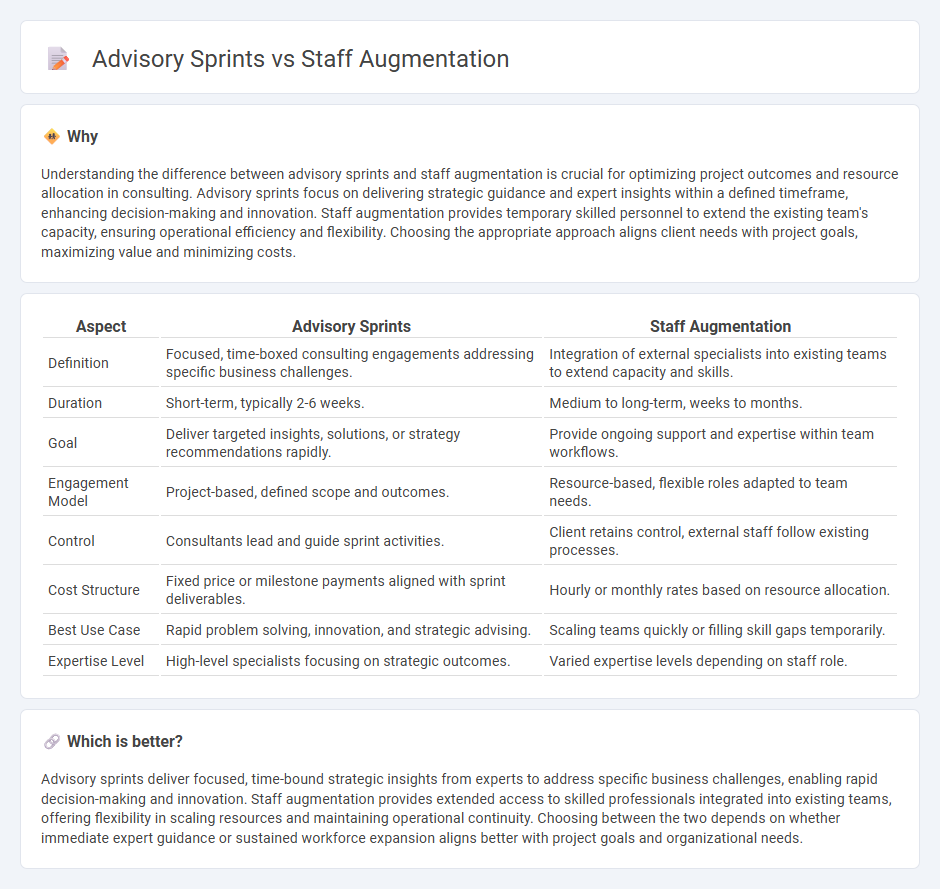
Advisory sprints offer targeted, high-impact consulting engagements designed to address specific business challenges swiftly, leveraging expert insights without long-term commitments. Staff augmentation provides scalable resource support by integrating specialized professionals directly into clients' teams to enhance capacity and expertise on an ongoing basis. Explore how advisory sprints and staff augmentation can transform your project delivery and operational efficiency.
Why it is important
Understanding the difference between advisory sprints and staff augmentation is crucial for optimizing project outcomes and resource allocation in consulting. Advisory sprints focus on delivering strategic guidance and expert insights within a defined timeframe, enhancing decision-making and innovation. Staff augmentation provides temporary skilled personnel to extend the existing team's capacity, ensuring operational efficiency and flexibility. Choosing the appropriate approach aligns client needs with project goals, maximizing value and minimizing costs.
Comparison Table
| Aspect | Advisory Sprints | Staff Augmentation |
|---|---|---|
| Definition | Focused, time-boxed consulting engagements addressing specific business challenges. | Integration of external specialists into existing teams to extend capacity and skills. |
| Duration | Short-term, typically 2-6 weeks. | Medium to long-term, weeks to months. |
| Goal | Deliver targeted insights, solutions, or strategy recommendations rapidly. | Provide ongoing support and expertise within team workflows. |
| Engagement Model | Project-based, defined scope and outcomes. | Resource-based, flexible roles adapted to team needs. |
| Control | Consultants lead and guide sprint activities. | Client retains control, external staff follow existing processes. |
| Cost Structure | Fixed price or milestone payments aligned with sprint deliverables. | Hourly or monthly rates based on resource allocation. |
| Best Use Case | Rapid problem solving, innovation, and strategic advising. | Scaling teams quickly or filling skill gaps temporarily. |
| Expertise Level | High-level specialists focusing on strategic outcomes. | Varied expertise levels depending on staff role. |
Which is better?
Advisory sprints deliver focused, time-bound strategic insights from experts to address specific business challenges, enabling rapid decision-making and innovation. Staff augmentation provides extended access to skilled professionals integrated into existing teams, offering flexibility in scaling resources and maintaining operational continuity. Choosing between the two depends on whether immediate expert guidance or sustained workforce expansion aligns better with project goals and organizational needs.
Connection
Advisory sprints and staff augmentation both address immediate business needs by rapidly deploying expert resources to solve complex challenges. Advisory sprints focus on delivering targeted strategic insights and actionable recommendations within a short timeframe, while staff augmentation supplements existing teams with specialized professionals to enhance capacity and expertise. Together, they provide a flexible approach to accelerating project delivery and enabling organizations to scale expertise efficiently.
Key Terms
Resource allocation
Staff augmentation provides businesses with scalable access to skilled professionals who seamlessly integrate into existing teams, optimizing resource allocation by filling specific talent gaps efficiently. Advisory sprints concentrate on short-term, focused expertise deliveries that guide strategic decisions without long-term commitments, enabling precise allocation of advisory resources. Explore how these approaches can enhance your project outcomes and resource management.
Deliverables
Staff augmentation delivers skilled personnel integrated into existing teams to accelerate project timelines and enhance capacity with measurable output. Advisory sprints provide strategic consulting in short, focused cycles, producing actionable recommendations and optimized processes tailored to specific business challenges. Explore how each approach can maximize your project deliverables by diving deeper into their unique benefits.
Engagement duration
Staff augmentation typically involves long-term engagement durations, allowing businesses to integrate skilled professionals directly into their teams for extended projects or ongoing support. Advisory sprints focus on short-term, intensive collaborations designed to provide expert guidance and strategic insights within a few weeks. Explore the key differences in engagement duration to determine which approach best suits your project needs.
Source and External Links
Pros and Cons of Staff Augmentation : A Detailed Look - Staff augmentation is a staffing model where businesses hire external professionals for specific projects to quickly fill skill gaps and accelerate growth, though it requires careful management to avoid integration and cost challenges.
Staff augmentation - Staff augmentation is an outsourcing strategy used to supplement a company's workforce with contract workers or consultants to address project-specific staffing needs and business objectives.
What is Staff Augmentation? Benefits and Best Practices - Staff augmentation enables companies to flexibly hire short-term, specialized talent to work alongside their permanent teams, offering a practical solution to talent shortages and project demands without the long-term commitment of traditional hiring.
 dowidth.com
dowidth.com